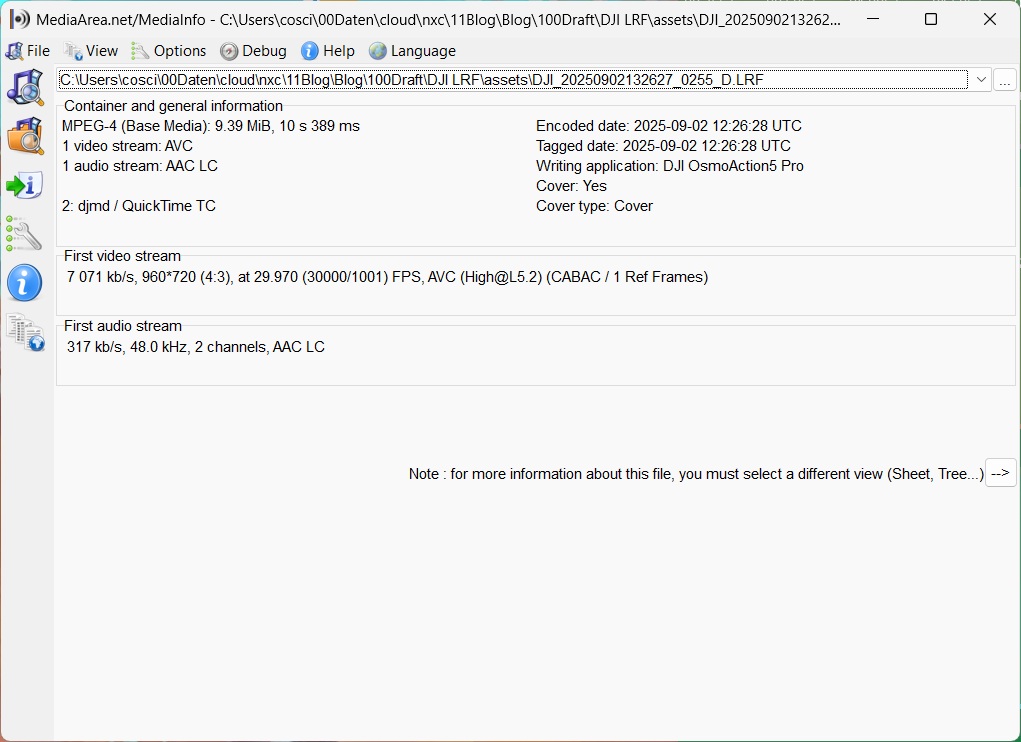- What Are DJI LRF Files?
- What Can LRF Files Be Used For?
- Are LRF Files the Same as Proxy Clips?
- How to Play LRF Files
- Which Programs Support Proxy Clips / LRF Files?
- Which DJI Devices Create LRF Files?
- Do Other Cameras Create Proxy Clips?
- FAQ – Frequently Asked Questions About DJI LRF and Proxy Clips
- Glossary – Key Terms Explained
- Your Feedback Matters!
DJI LRF Files and Proxy Clips – Explained in Simple Terms
When filming with a DJI Action 5 Pro (*), DJI Pocket 3 (*) or DJI Drone (*) you may notice extra files with the extension .LRF alongside your regular MP4 videos. Many users wonder: What are these files? Do I need them?
In this guide, I’ll explain in simple terms what DJI LRF files are, why they’re useful, and how you can make the most out of them.
What Are DJI LRF Files?
- LRF stands for Low Resolution Files.
- They are small proxy video files in 720p (960×720, 4:3).
- The bitrate is around 7–8 Mbit/s.
- They are automatically created in addition to your main 4K or 2.7K clips when the option is enabled in your camera.
What Can LRF Files Be Used For?
LRF files have several benefits:
- Proxy Editing
- High-resolution 4K or 5.3K video clips are huge and require powerful hardware.
- With lightweight LRF proxy files, you can edit smoothly and later relink your project to the original high-res footage.
- Quick Preview
- Review your shots instantly without loading massive video files.
- Storage-Friendly on the Go
- Perfect for quickly watching or sharing clips on your phone without transferring gigabytes of data.
- Team Collaboration
- Instead of uploading gigabytes of 4K video, you can share small proxy files with teammates.
- These can easily be shared via Dropbox, Google Drive, OneDrive, or WeTransfer.
- Multiple editors can work on the same project at once without needing access to the heavy original files.
Are LRF Files the Same as Proxy Clips?
Yes – essentially, LRF files are DJI’s version of proxy clips.
- A proxy clip is a smaller copy of your original footage designed to make editing smoother.
- The difference:
- Traditional proxy clips are often created inside your editing software (e.g., Premiere Pro, DaVinci Resolve, Kdenlive).
- DJI cameras generate LRF proxy files in-camera, saving you the time and effort of generating them manually.
How to Play LRF Files
Windows doesn’t natively recognize .LRF files, but there are simple solutions:
- Rename the file extension from .LRF to .MP4 – then open it with any video player.
- Play directly in VLC Media Player:
- Right-click → Open with → VLC Media Player
- Or simply drag & drop the file into an open VLC window.
This way, you can preview LRF files instantly without conversion.
Which Programs Support Proxy Clips / LRF Files?
Most professional editing programs support proxy workflows, including:
- Adobe Premiere Pro
- DaVinci Resolve
- Final Cut Pro (Mac)
- Vegas Pro
- Kdenlive (free and open-source)
Tip: Import your LRF proxy files for smooth editing, then relink to your high-resolution originals for final export.
Which DJI Devices Create LRF Files?
- DJI Action cameras (e.g., Action 3, Action 4, Action 5 Pro)
- DJI Pocket series (Pocket 2, Pocket 3)
- DJI drones (Mavic, Air, Mini, depending on model & firmware)
Do Other Cameras Create Proxy Clips?
Yes, several other brands also support proxy workflows:
- GoPro (*): With the GoPro Labs Custom Firmware, you can enable proxy recording optimized for Premiere Pro or DaVinci Resolve.
- Sony & Canon: Many professional camcorders and mirrorless cameras offer built-in proxy recording (usually in HD).
FAQ – Frequently Asked Questions About DJI LRF and Proxy Clips
Do I need LRF files?
No – they are optional. But for editing, they can save you time and computer resources.
Can I use only LRF files?
For previews, yes. For final export, no – they are limited to 720p and not suitable for high-quality output.
How much storage do LRF files save?
A lot – a 5-minute 4K clip can take up several gigabytes, while its LRF proxy might only be a few megabytes.
Why are my LRF files black or unplayable?
That’s usually because the player doesn’t recognize the format. Rename them to .MP4 or open directly in VLC.
Glossary – Key Terms Explained
- Proxy Clip: A smaller version of a video used for easier editing.
- LRF: DJI’s file format for proxy clips (Low Resolution File).
- Bitrate: The amount of data processed per second – higher bitrate = better quality.
- 720p: HD resolution (1280×720 pixels, DJI’s LRF is 960×720).
- VLC Player: Free media player that can open almost any video file.
Your Feedback Matters!
👉 Have you worked with LRF files or proxy clips before?
👉 Which editing software do you use them with?
Share your thoughts or questions in the comments – I’d love to hear your experiences!
(*) Affiliate Links






